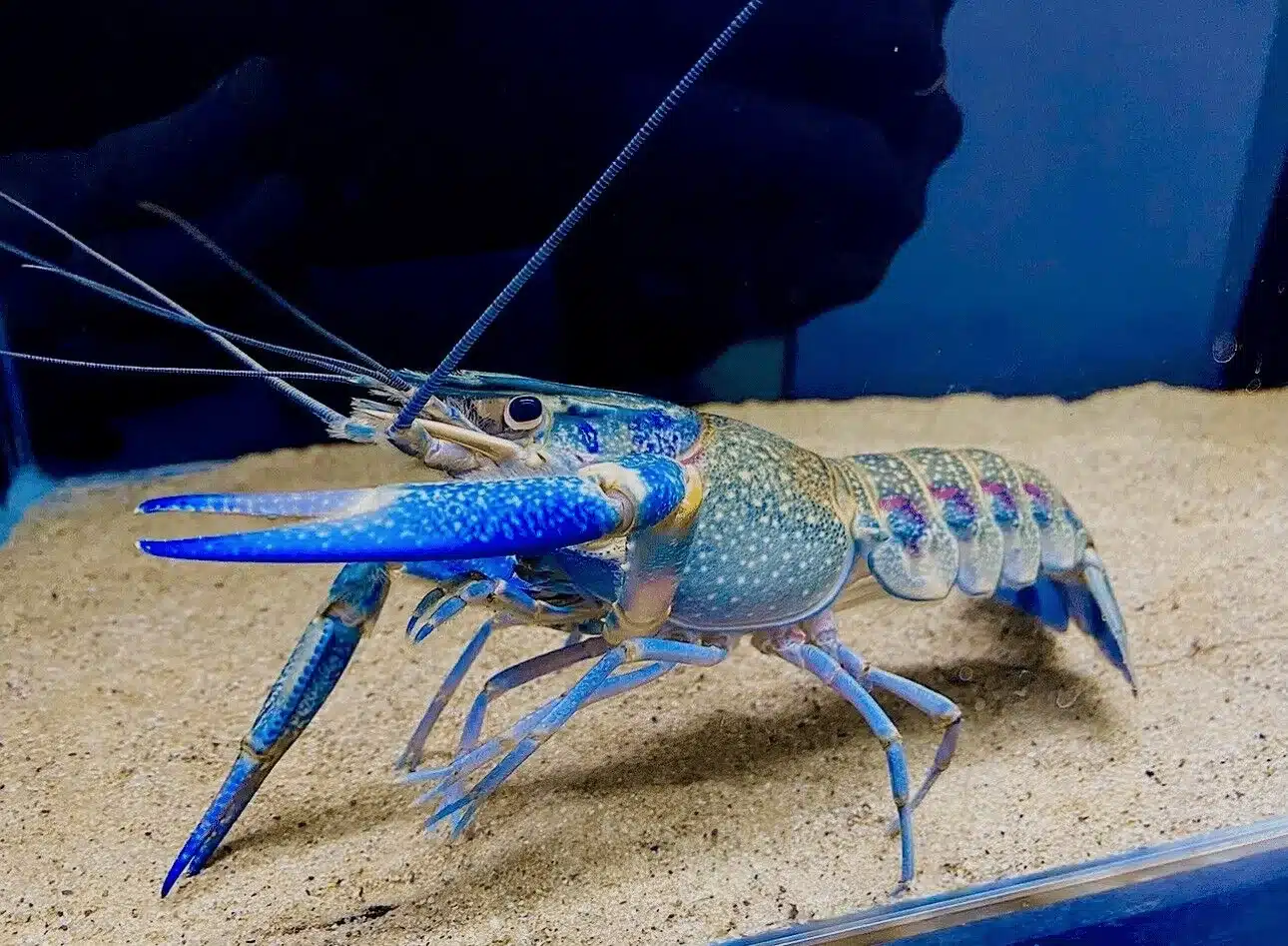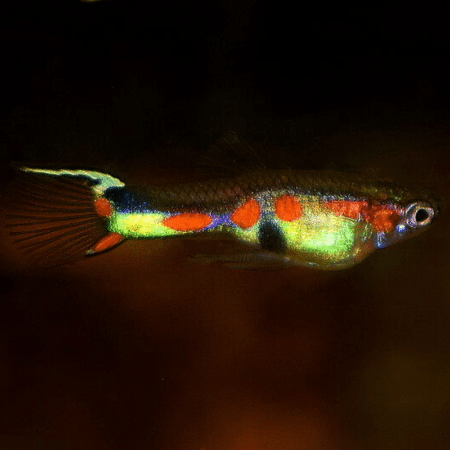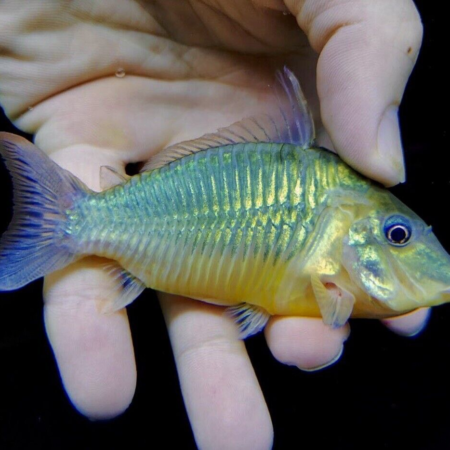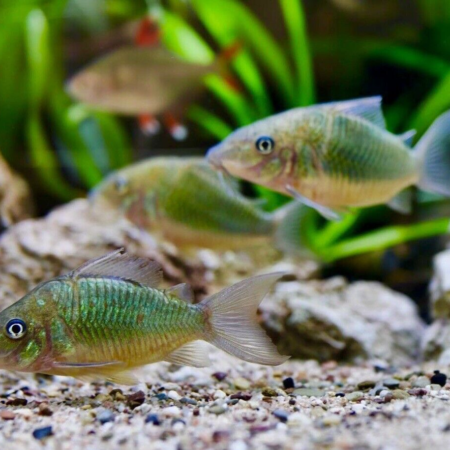Red Claw Blue Lobster CRAYFISH – Cherax quadricarinatus -3-4 Cm, Thriving Freshwater Crustacean, Perfect Companions for Aquatic Plants and Enriching Tank Environments
£11.99 Original price was: £11.99.£9.99Current price is: £9.99.
Welcome these beautiful Red Claw Blue Lobsters (Cherax quadricarinatus) into your aquarium. Their stunning blue coloration and graceful movements make them captivating inhabitants. Ideal for aquarists seeking peaceful companions among freshwater crayfish and aquarium plants.
Species Introduction
The Red Claw Blue Lobster, scientifically known as Cherax quadricarinatus, is a fascinating species of freshwater crayfish that originates from the tropical regions of Australia and New Guinea. These vibrant invertebrates are renowned for their striking blue coloration, which is particularly pronounced in males, and their distinctive red claws. In their natural habitat, they inhabit freshwater rivers, streams, and lakes, often seeking refuge among rocks and aquatic vegetation. This species is not only captivating for aquarists but also plays a crucial role in the ecosystem by contributing to the breakdown of organic matter and providing a food source for various predators. As you consider providing a loving home for these beautiful creatures, it’s essential to understand their unique needs and behaviors to ensure a thriving environment.
Care Requirements Dashboard
Essential Care Guide for Your Red Claw Blue Lobster CRAYFISH – Cherax quadricarinatus – 3-4 Cm
| Optimal Living Conditions | |
|---|---|
| Water Temperature | 24-27°C (75-81°F) |
| pH Level | 6.5-7.5 |
| Water Hardness | 4-12 dKH |
| Minimum Tank Size | 80L (20 gal) |
| Salinity | Freshwater |
| Care Level | Beginner Friendly |
Natural Behavior & Temperament
The Red Claw Blue Lobster exhibits a range of interesting behaviors that make them a joy to observe in a home aquarium. They are primarily nocturnal, becoming more active during the night when they forage for food. During the day, they tend to hide in crevices or under decorations, which is a natural behavior that helps them feel secure. In terms of temperament, these crayfish can be territorial, especially males, and may display aggressive behavior towards each other or other tank mates, particularly if there are not enough hiding spots. When introducing them to a community tank, it’s crucial to choose compatible tank mates that can coexist peacefully, such as larger fish or other non-aggressive invertebrates.
Tank Setup Guide
Setting up a suitable environment for your Red Claw Blue Lobster involves creating a habitat that mimics their natural surroundings. Start with a substrate of fine gravel or sand, which allows them to burrow and dig, an instinctual behavior they exhibit in the wild. Incorporate various decorations such as rocks, driftwood, and caves to provide hiding spots and territories. Live aquarium plants can also enhance the aesthetic appeal of the tank while offering additional cover. Plants like Java Fern or Anubias are excellent choices, as they can withstand the occasional nibbling from your crayfish. Ensure that the tank has a secure lid, as these curious creatures are known to escape if given the opportunity. Additionally, consider the placement of your filtration system to avoid strong currents that could stress them.
Water Quality Management
✓ Water Parameters: pH 6.5-8.0, Temperature 22-28°C
Maintaining proper water quality is essential for the health and longevity of your Red Claw Blue Lobster. Regular testing of water parameters such as pH, ammonia, nitrite, and nitrate levels is crucial. Aim for a pH level between 6.5 and 8.0, with stable hardness ranging from 5 to 15 dGH. The temperature should be kept between 22°C and 28°C (72°F to 82°F). Use a reliable heater and thermometer to monitor the temperature closely, as fluctuations can stress these crustaceans. Additionally, ensure that ammonia and nitrite levels remain at 0 ppm, while nitrates should be kept below 20 ppm. Regular water changes and a good filtration system will help maintain these parameters, contributing to a healthy environment for your aquatic companions.
Feeding & Nutrition
Feeding your Red Claw Blue Lobster a balanced diet is vital for their growth and overall health. In the wild, these crayfish are omnivorous scavengers, consuming a variety of plant matter, detritus, and small invertebrates. In captivity, you can provide a diet consisting of high-quality pellets formulated for crustaceans, blanched vegetables such as zucchini and spinach, and occasional protein sources like bloodworms or shrimp. It is recommended to feed them once every other day, offering only what they can consume in a few hours to prevent overfeeding and maintain water quality. Monitor their feeding habits closely, as they can be picky eaters and may require some time to adjust to new foods. Additionally, ensure that any uneaten food is promptly removed from the tank to prevent water contamination.
Compatibility Guide
✓ Suitable Tank Mates: Larger Fish, Non-Aggressive Invertebrates
When considering tank mates for your Red Claw Blue Lobster, it is essential to choose species that can coexist peacefully. Larger fish such as cichlids or barbs can make suitable companions, as they are less likely to be viewed as prey. Avoid smaller or more docile fish, as they may become targets for the crayfish’s territorial behavior. Non-aggressive invertebrates, such as snails or certain shrimp species, can also be good tank mates, provided they are not too small. It is crucial to monitor interactions closely, especially during the initial introduction phase. Providing ample hiding spots and territories can help reduce aggression and ensure a harmonious community tank.
Health & Wellness
Ensuring the health and wellness of your Red Claw Blue Lobster involves regular monitoring and prompt attention to any signs of illness. Common health issues include shell disease, which can occur due to poor water quality or stress. Signs of shell disease may include discoloration or soft spots on the shell. Additionally, keep an eye out for any unusual behavior, such as lethargy or loss of appetite, as these can indicate underlying health problems. To prevent illness, maintain optimal water parameters, provide a varied diet, and ensure a stress-free environment. If you notice any concerning symptoms, consider consulting with an aquatic veterinarian for guidance on treatment options.
Breeding Information
✓ Breeding Conditions: Separate Breeding Tank Recommended
Breeding Red Claw Blue Lobsters can be a rewarding experience, but it requires specific conditions to succeed. To encourage breeding, it is advisable to set up a separate breeding tank with optimal water parameters, including slightly warmer temperatures and stable pH levels. Males can be identified by their larger claws and more vibrant coloration, while females are typically smaller and possess a broader abdomen. After successful mating, the female will carry the fertilized eggs under her tail for several weeks until they hatch. Once the eggs hatch, the fry will require finely crushed food and a well-maintained environment to thrive. It is crucial to ensure that the breeding tank is free of aggressive tank mates, as the fry are vulnerable during this stage.
Acclimation Process
Acclimating your Red Claw Blue Lobster to a new environment is a critical step in ensuring their successful transition. Begin by floating the sealed bag containing the crayfish in the aquarium for about 15-20 minutes to equalize the temperature. After this, gradually introduce small amounts of tank water into the bag over the course of an hour. This process helps the crayfish adjust to the water chemistry of the new tank. Once acclimated, gently release the lobster into the tank, avoiding any sudden movements that could stress them. It is advisable to turn off the aquarium lights during the acclimation process to minimize stress. Monitor their behavior closely for the first few days to ensure they are adjusting well to their new home.
Long-term Care
Long-term care of your Red Claw Blue Lobster involves understanding their growth expectations and lifespan. In a well-maintained aquarium, these crayfish can live for 5-7 years, provided they receive proper care. As they grow, they may require larger hiding spots and more space to accommodate their increased size. Regular monitoring of their health and water quality is essential, as any fluctuations can impact their longevity. Additionally, consider their molting process, which occurs as they grow. During molting, crayfish are vulnerable, so it is crucial to provide a stress-free environment and avoid any aggressive tank mates during this time. By providing a stable environment and proper nutrition, you can enjoy the beauty and personality of your Red Claw Blue Lobster for many years.
Natural Habitat Recreation
✓ Biotope Setup: Mimic Natural Environment
Recreating the natural habitat of the Red Claw Blue Lobster in your aquarium enhances their well-being and allows for more natural behaviors. To achieve this, focus on incorporating elements such as rocks, driftwood, and live plants that resemble their native environment. Use a substrate that allows for burrowing, and ensure that there are plenty of hiding spots to provide security. Additionally, consider the water flow and lighting conditions, as these factors can significantly impact their comfort and activity levels. By mimicking their natural habitat, you not only create a beautiful display but also promote a healthy and stress-free environment for your aquatic companions.
Seasonal Care Adjustments
As seasons change, it is important to adjust your care routine for your Red Claw Blue Lobster to ensure their continued health and happiness. During warmer months, monitor the water temperature closely, as it can rise quickly in heated tanks. If necessary, use fans or chillers to maintain the ideal temperature range. In colder months, ensure that the heater is functioning properly to prevent temperature drops that can stress your crayfish. Additionally, consider adjusting the lighting duration to mimic natural daylight cycles, promoting a more natural rhythm for your aquatic companions. Regularly check for any changes in behavior or health during seasonal transitions, as these can indicate stress or discomfort.
Expert Tips
✓ Professional Advice: Monitor Behavior Closely
To ensure the best care for your Red Claw Blue Lobster, it is essential to monitor their behavior closely and make adjustments as needed. If you notice any signs of stress, such as hiding more than usual or aggressive behavior, consider evaluating their environment for potential stressors. Providing a varied diet can also help stimulate their appetite and encourage natural foraging behaviors. Additionally, be mindful of their molting process, as this is a critical time for their health. Offering calcium-rich foods during this period can support shell development and overall well-being. By staying attentive to their needs and behaviors, you can foster a thriving and vibrant community in your aquarium.
Troubleshooting
Despite your best efforts, you may encounter challenges while caring for your Red Claw Blue Lobster. Common issues include aggressive behavior towards tank mates or signs of illness. If aggression arises, consider providing additional hiding spots and territories to reduce competition. If you notice signs of illness, such as lethargy or abnormal coloration, check water parameters immediately and perform a water change if necessary. Additionally, ensure that your crayfish are not being stressed by aggressive tank mates. If problems persist, consulting with an aquatic veterinarian can provide valuable insights and treatment options. Remember, patience and observation are key to resolving issues and ensuring a healthy environment for your aquatic friends.
Scientific Background
✓ Taxonomy: Cherax quadricarinatus
The Red Claw Blue Lobster belongs to the family Parastacidae, which encompasses various species of freshwater crayfish. Within the Cherax genus, Cherax quadricarinatus is particularly notable for its vibrant coloration and adaptability to different aquatic environments. Research indicates that this species has a significant ecological role in its native habitats, contributing to nutrient cycling and serving as prey for larger aquatic animals. Conservation efforts are essential to protect their natural habitats, as freshwater ecosystems face numerous threats from pollution and habitat destruction. Understanding the scientific background of your aquatic companions enhances your appreciation for their role in the ecosystem and the importance of responsible care.
Advanced Care Techniques
For those looking to take their care of Red Claw Blue Lobsters to the next level, consider implementing advanced techniques such as breeding programs or specialized feeding regimens. Breeding these crayfish can be a rewarding endeavor, allowing you to observe their natural reproductive behaviors and raise fry. Additionally, experimenting with different food types, including homemade recipes, can provide a varied diet that promotes optimal health and coloration. Incorporating supplements like spirulina or calcium can further enhance their diet and support shell development. By engaging in advanced care techniques, you not only enrich the lives of your aquatic companions but also deepen your understanding of their biology and needs.
Water Quality Parameters
Optimal Range
24-27°C
6.5-7.5
0 ppm
Caution Zone
22-24°C or 27-29°C
6.0-6.5 or 7.5-8.0
0.25-0.5 ppm
Danger Zone
<22°C or >29°C
<6.0 or >8.0
>0.5 ppm
Monitoring Tip: Test water parameters weekly and perform regular water changes to maintain optimal conditions for your aquatic friends!
Frequently Asked Questions
Q: What tank size is required for the Red Claw Blue Lobster Crayfish?
The Red Claw Blue Lobster Crayfish, or Cherax quadricarinatus, requires a minimum tank size of 60 litres. This ensures ample space for movement and territorial behaviour, which is crucial for their well-being. A larger tank is preferable as it allows for better water quality management and provides hiding spots, essential for their comfort. The tank should also be equipped with a secure lid, as these crayfish are known to be escape artists. Proper filtration is also vital to maintain water quality, as they are sensitive to changes in their environment.
✓ Expert Tip
Consider adding rocks, caves, or PVC pipes as hiding spots to reduce stress and aggression.
Q: What water parameters do Red Claw Blue Lobsters require?
Red Claw Blue Lobsters thrive in water with a temperature range of 22-28°C and a pH level between 6.5 and 8.0. They prefer slightly hard water, with a hardness of 10-15 dGH. Regular testing of these parameters is essential to prevent stress and disease. Additionally, ammonia and nitrite levels should be kept at 0 ppm, while nitrate levels should be below 20 ppm. Conducting regular water changes of 10-20% weekly can help maintain these conditions and ensure a healthy environment.
✓ Expert Tip
Invest in a reliable water testing kit to monitor parameters regularly.
Q: How often should I feed my Red Claw Blue Lobster?
Feeding your Red Claw Blue Lobster should be done every other day, with a small amount of food that they can consume within a few minutes. A varied diet is essential; you can provide high-quality pellets, blanched vegetables, and occasional protein such as shrimp or fish. Overfeeding can lead to water quality issues, so it is important to monitor their intake. Additionally, ensure that any uneaten food is promptly removed to maintain a clean environment.
✓ Expert Tip
Consider incorporating a calcium supplement to support their shell health.
Q: What are the best tank mates for Red Claw Blue Lobsters?
Red Claw Blue Lobsters can be territorial and may exhibit aggression towards smaller or similarly-sized tank mates. Suitable companions include larger fish that are not overly aggressive, such as cichlids or larger tetras. Avoid keeping them with smaller fish or invertebrates, as they may become prey. It’s advisable to introduce tank mates simultaneously to reduce territorial disputes. Always monitor their interactions closely, especially in the initial stages.
✓ Expert Tip
Provide ample hiding spaces to help reduce aggression among tank mates.
Q: How do I properly acclimatise my Red Claw Blue Lobster to my aquarium?
Acclimatising your Red Claw Blue Lobster is crucial for its health. Begin by floating the sealed bag in your aquarium for about 15-20 minutes to equalise the temperature. After that, gradually introduce aquarium water into the bag over another 30-45 minutes by adding small amounts every 5-10 minutes. This process helps the lobster adjust to the water parameters. Once acclimatised, gently place the lobster into the tank using a net, avoiding adding bag water to your aquarium.
✓ Expert Tip
Avoid sudden changes in water temperature or chemistry to minimise stress.
Q: What are the signs of a healthy Red Claw Blue Lobster?
Healthy Red Claw Blue Lobsters exhibit vibrant colouration, active movement, and a robust shell. Look for clear, bright eyes and well-formed claws. Their behaviour should include foraging and exploring their environment. Any signs of lethargy, faded colour, or abnormal behaviour can indicate stress or illness. Regular monitoring of their environment and diet can help maintain their health. Keeping an eye out for any changes will allow you to address potential issues early.
✓ Expert Tip
Regular water changes and quality food are key to sustaining their health.
Q: How do I successfully breed Red Claw Blue Lobsters?
Breeding Red Claw Blue Lobsters can be a rewarding experience. To stimulate breeding, maintain optimal water parameters and provide plenty of hiding places. A female will carry fertilised eggs under her tail until they hatch, which can take around 4-6 weeks. After hatching, ensure the fry have small food options, such as powdered food or finely crushed flakes. It is advisable to separate the fry from adults to prevent predation. Regular water changes and monitoring will help ensure a successful breeding environment.
✓ Expert Tip
Provide high-quality food to enhance fry growth and health.
Q: What temperature should I maintain for my Red Claw Blue Lobster?
Red Claw Blue Lobsters thrive best in a temperature range of 22-28°C. Maintaining a stable temperature within this range is crucial for their metabolic processes and overall health. Sudden fluctuations can lead to stress and susceptibility to illness. Using a reliable aquarium heater and thermometer can help ensure that the temperature remains consistent. Regular monitoring is essential, especially during seasonal changes, to prevent any adverse effects on your aquatic companions.
✓ Expert Tip
Consider using a heater with a thermostat for precise temperature control.
Q: How long do Red Claw Blue Lobsters typically live in captivity?
In captivity, Red Claw Blue Lobsters can live for approximately 5-7 years, provided they are given proper care and optimal living conditions. Factors such as water quality, diet, and tank environment significantly influence their lifespan. Regular monitoring and maintenance of their habitat can help prevent diseases and stress, ultimately contributing to a longer, healthier life. Establishing a routine for water changes and feeding will also support their well-being.
✓ Expert Tip
Ensure a balanced diet and stable environment to maximise their lifespan.
Q: What type of substrate is most suitable for Red Claw Blue Lobsters?
A sandy or fine gravel substrate is ideal for Red Claw Blue Lobsters, as it allows them to burrow and exhibit natural behaviour. Avoid sharp substrates that could injure their delicate bodies. A depth of at least 5 cm is recommended to accommodate their burrowing habits. Additionally, incorporating natural decorations such as rocks and driftwood can enhance their environment, providing hiding spots and reducing stress.
✓ Expert Tip
Rinse the substrate thoroughly before adding it to the tank to remove any dust.
Q: What behavioural patterns should I expect from Red Claw Blue Lobsters?
Red Claw Blue Lobsters are generally active and curious creatures. They will spend a lot of time exploring their environment, foraging for food, and occasionally displaying territorial behaviour, especially during mating season or when feeling threatened. They may also exhibit hiding behaviour, often retreating to shelters or caves when feeling insecure. Observing these behaviours can help you gauge their comfort level and overall health in the aquarium.
✓ Expert Tip
Provide plenty of hiding spots to help them feel secure and reduce stress.
Q: How can I prevent common diseases in Red Claw Blue Lobsters?
Preventing diseases in Red Claw Blue Lobsters involves maintaining optimal water quality and a stress-free environment. Regular water changes and monitoring parameters such as pH, ammonia, and nitrites are essential. Ensure a varied diet rich in nutrients to support their immune system. Avoid overcrowding the tank, as this can lead to stress and aggression, which are precursors to illness. Additionally, quarantining new tank mates before introducing them can help prevent the spread of pathogens.
✓ Expert Tip
Consider adding aquarium salt to support gill function and overall health.
Q: What lighting conditions do Red Claw Blue Lobsters prefer?
Red Claw Blue Lobsters prefer moderate lighting levels that mimic their natural habitat. They thrive in environments with natural shade provided by rocks, plants, and decorations. Bright lighting can stress them, so it is advisable to use adjustable LED lighting that can be dimmed. A light cycle of 10-12 hours per day is generally suitable, allowing for a natural day-night rhythm, which is crucial for their overall health and behaviour.
✓ Expert Tip
Avoid direct sunlight on the aquarium, as it can lead to algae blooms.
Q: How do I recognise stress in my Red Claw Blue Lobster?
Signs of stress in Red Claw Blue Lobsters can include lethargy, loss of colour, hiding excessively, or aggressive behaviour towards tank mates. They may also exhibit unusual postures, such as curling their bodies. Monitoring these behaviours closely can help you identify potential stressors in their environment, such as poor water quality, aggressive tank mates, or inadequate hiding spots. Addressing these issues promptly can help restore their comfort and overall health.
✓ Expert Tip
Regularly check water parameters to prevent stress-related issues.
Q: What natural habitat conditions should I replicate for Red Claw Blue Lobsters?
To create an ideal habitat for Red Claw Blue Lobsters, mimic their natural environment by providing plenty of hiding spots, such as caves and dense vegetation. The substrate should be soft, allowing them to burrow comfortably. Maintain slightly alkaline water with moderate hardness, and ensure a temperature range of 22-28°C. Proper filtration and aeration are crucial to replicate their natural water conditions, enhancing their overall well-being and behaviour.
✓ Expert Tip
Utilise natural decorations to enhance the aesthetic and functional aspects of the habitat.












Emily Carter (verified owner) –
I recently purchased the Red Claw Blue Lobster crayfish (Cherax quadricarinatus) for my freshwater tank, and I couldn’t be happier! After just two weeks, I can see how well they have adapted. Their bright colors really pop against the greenery of my aquarium, and they are surprisingly active! I love watching them forage and explore. It’s clear they appreciate the hiding spots I’ve provided; their natural behavior is fascinating to observe. Compared to other crayfish I’ve had in the past, these are much more lively and engaging. While they have been a little nippy with my smaller fish, it’s nothing too concerning as I made sure to house them with appropriately sized tank mates. They seem to thrive on a diet of quality fish food, and I’ve noticed their shells becoming even shinier! I definitely recommend these little guys to any freshwater aquarium enthusiast looking to add some personality and color to their setup. Just be sure to do a little research on compatibility to ensure everyone gets along. Overall, a fantastic purchase that I will certainly make again in the future!